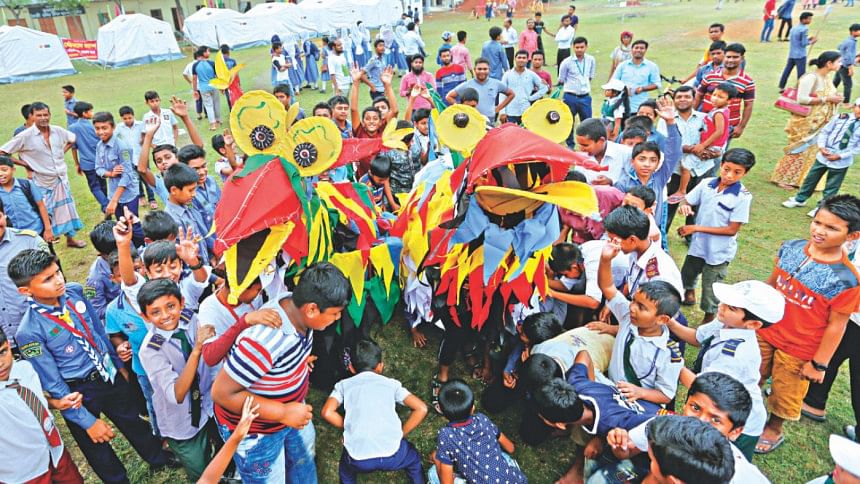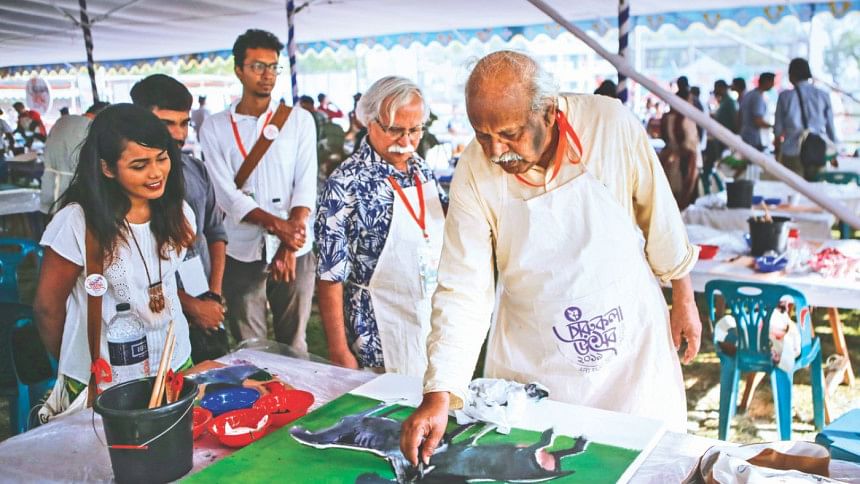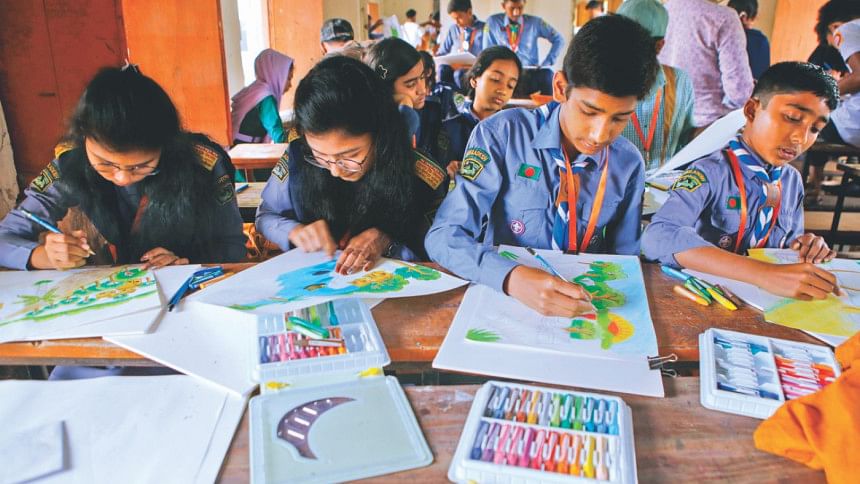The significance of Charukola Art Festival

Ask just about anyone who's passed through high school in Bangladesh to talk about the banality of art and music classes throughout school, and it would be possible to sum up the collective experience of an entire generation of school going children with a lazily drawn scene of a village house, swaying palm trees, a slithering river in the background, and a conveniently placed cow. Week after week, year after year. The young artists volunteering at Charukola's art camp this year noticed the same plight among the schoolchildren they were tasked with mentoring.
Charukola's second ever art festival of this kind was a four day event from March 27-30, 2019, held at Bhawal Mirzapur Haji Jamir Uddin School and College in Gazipur, organised in an effort to move art away from the city centre of Dhaka, and instead to communities that don't often get the opportunity to engage with art and artists. Renowned artists such as Rafiqun Nabi, Farida Zaman, Mohammad Eunus, Sheikh Afzal Hossain, Afrozaa Jamil Konka, Fareha Zeba, and many more were in attendance. Locals came in droves to watch these esteemed artists work over the course of the event. Hundreds of young artists from various fine art institutions from every corner of the country also made the journey to Bhawal. While locals poured in over the course of the festival to get the once in a lifetime experience of watching such esteemed artists at work all under the same roof, the essence of the festival was truly rooted in the workshop classes held for the students of the school.
Prior to the arrival of the senior artists, their younger counterparts had already spent a full day with the young girls and boys of Bhawal Mirzapur Haji Jamir Uddin School. The students were broken off into multiple groups and each group was assigned to a young artist. The group would then go on to carve out a space for their drawing sessions. Many chose to set up on campus, while others ventured into town or deeper into the countryside, finding themselves stationed under the shade of trees or sitting atop a hill. Unlike the aforementioned school art classes (the nature of which most of us are unfortunately familiar with), the mentors would give the students full liberty to draw whatever they wanted and help them further the translation of their vision step by step. Unfortunately, the artists soon realised that everyone had begun drawing the same scene: village house, swaying palm tree, and cow. When asked why, the general consensus was that this was all that they knew how to draw. Later that night, the artists would bring their observations to the organisers, but at that moment, they had wasted half of the day and it became obvious to those mentoring that these children were not having fun. They were treating the art camp as an assignment instead of enjoying it.

It's a problem that upon first glance might not seem like a big deal, however it's indicative of the wider problem with how the arts are viewed in our present-day culture, especially in rural areas where they are deemed to be surplus to requirements in most schools. This isn't unique to Bangladesh or even the sub-continent. Education boards all across the world have consistently been scrutinised for slashing funding for art, music, and physical education classes. Let's be honest: materials don't come cheap, irrespective of school or household. It's hard to justify spending money on an assortment of art supplies when there are far more pressing concerns to deal with. But the way most art classes are conducted throughout the country are more in line with keeping students occupied for a period throughout the school day.
Furthermore, what comes off as blasphemy for both aspiring and established artists alike, is the focus on copying something from the exam syllabus in an effort to maximise grades. Rather than impart children with skills they can use to create their own original work, teachers prioritise exam success. This is counter-intuitive to art classes, where creativity should be championed. Of course exams are important and the reasons behind this go far deeper than can be covered here, but it all results in yet another generation unable to cherish their creativity.

Perhaps this is why there has been such positivity around the festival. "Such an art festival rarely happens in Bangladesh," said celebrated artist RafiqunNabi, who formally inaugurated the art camp. "As artists, we want to relay our feelings and emotions through art. Beautiful thoughts and joyfulness are prerequisites to the job." The senior artists attending the festival are a testament themselves to the importance of art at both personal and national levels.
The mentors would change their approach after the mid-day hiccup. They urged the students in their splintered groups to draw inspiration from their surroundings. To acknowledge the things that interest them in their environment. When it was time for students to exhibit their work in the outdoor gallery, the students work had ended up covering more mature themes than were expected from them, almost exclusively focused on the rapid urbanisation of their spaces in images of the brickfields that surrounded their school, deforestation of the nearby vegetation, pollution of waterways and green spaces by local haat bazaars. That much alone makes this art festival a success.
Talat is a sub-editor at Shout and a visual artist. Reach him at @talatxhmed on Instagram.

 For all latest news, follow The Daily Star's Google News channel.
For all latest news, follow The Daily Star's Google News channel. 



Comments